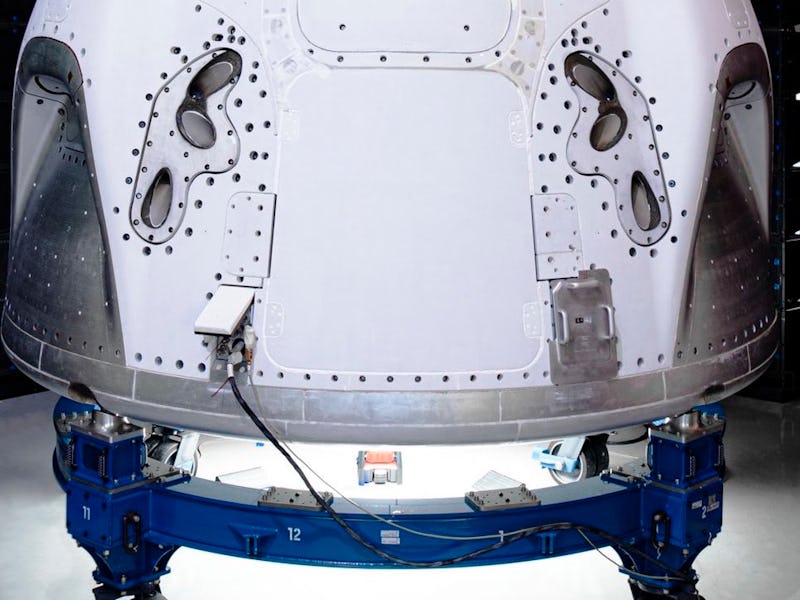SpaceX photo shows Crew Dragon after it has completed latest test
The human-carrying ship has completed its latest challenge.

SpaceX, Elon Musk's space-faring firm, has completed the next step in its quest to send humans into space.
On Monday, the company shared an image of the human-carrying Crew Dragon capsule after it completed its latest test. The capsule is part of NASA's Commercial Crew program: SpaceX and Boeing are both working to develop capsules that can ferry humans to and from the International Space Station.
In Monday's image, the Crew Dragon had just completed its acoustic testing in Florida. This test involves blasting the craft with speakers to simulate the vibrations it will feel during liftoff, a process that could expose its weak points.
Some of these tests can be quite rigorous: PopSci described a Lockheed Martin test in March 2016 where the team blasted the Orion capsule with 1,510 speakers firing 143 decibels. Think of the roar of a jet engine, and you're in the right ballpark.
SpaceX's test is an important step in the commercial capsule program, which could end NASA's current arrangement with Roscosmos. The Russian space agency rents out seats on Soyuz rockets to NASA at around $80 million each. The rockets take off from the Baikonur Cosmodrome in Kazakhstan. The arrangement came about after NASA ended the space shuttle program in 2011, leaving it without a means to continue sending astronauts to the space station to complete experiments.
With the Crew Dragon, expected to complete its first flight with humans sometime this year, that could all change.
The Crew Dragon photo shared by SpaceX.
SpaceX's capsule has been a long time coming. The agency chose SpaceX and Boeing as its partners for the program back in 2014. By August 2018, it had chosen the astronauts for the first flights. But early optimism gave way to realism, and by February 2019 NASA had extended its Roscosmos contract.
The first major test came in March 2019, when SpaceX launched the "Demo-1" capsule carrying cargo to the space station. Although SpaceX had completed numerous resupply missions using the standard Dragon craft, this represented a key test for its new-design capsule. The capsule carried a dummy called "Ripley," fitted with sensors to measure the effects on the body during flight.
The in-flight abort test came much later. This test would send up a Crew Dragon on a Falcon 9 rocket, abort the process mid-launch and see if the capsule's thrusters could escape from the rocket at a point when forces would be at their maximum. An anomaly during an internal test in April, 100 milliseconds before SpaceX was due to ignite the SuperDraco thrusters, led the company to make adjustments to its design. It later emerged that the company had issues during a parachute test in May.
Tensions rose between NASA and SpaceX ahead of the Starship unveiling, where Musk took the wraps off the ship designed to send humans to Mars. After NASA administrator Jim Bridenstine drew attention to the fact that Crew Dragon was behind schedule, Musk had to clarify at the launch that most of the company was working on Falcon 9 and Crew Dragon, with just five percent working on Starship.
SpaceX finally completed the in-flight abort test on January 19. During the post-launch conference, Musk declared the first manned flight could take place in the second quarter of 2020. Later reports suggested SpaceX was targeting May 7.
Ahead of the planned flight, SpaceX shared an image of the capsule in Florida ahead of its flight:
It's been a long time coming, but the Crew Dragon may soon be ready to send astronauts Bob Behnken and Doug Hurley into space. From there, the next stop in SpaceX's human flight endeavors could be a trip on the Starship.